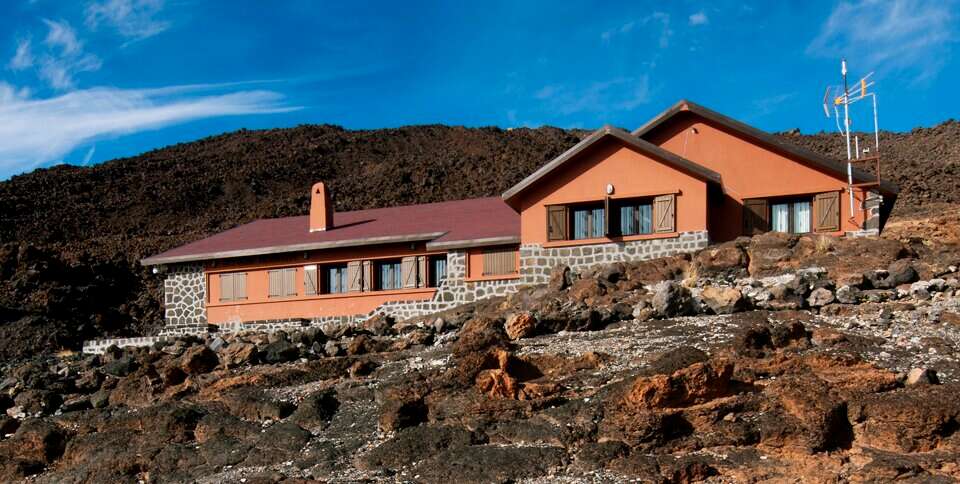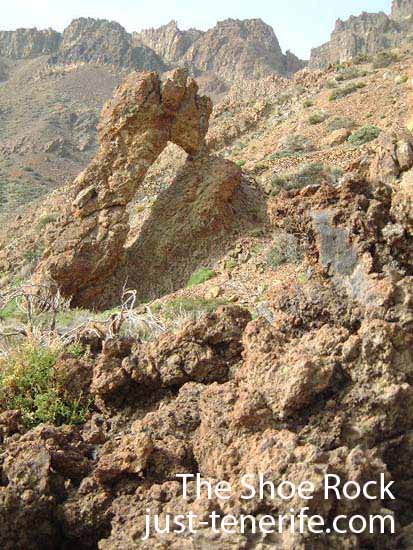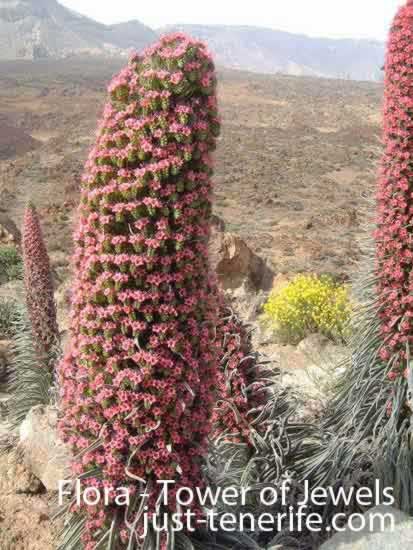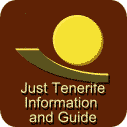Mount Teide National Park (Parque Nacional del Teide) Introduction
- Teide National Park, pronounced 'Tay day', is the the most popular national park not only in and attracts over 4 million visitors a year and consists of Mount Teide (Pico del Teide) it's second peak, Pico Viejo & the older surrounding Caldera. The caldera is the collaped core of a much older and much larger volcano
- Top of my list of Tenerife Top tourist holiday attractions
- With the impressive peak of Mount Teide an active but dormant Volcano in it's centre.
- Within the parkis also a major international astronomical observatory, The Teide Observatory,
Mount Teide Facts

Mount Teide covered in Winter snow
- Mount Teide, is in the centre of Teide National Park and nearer to the North coast of Tenerife than the South Coast
- Mount Teide, is the heighest mountain in Spain
- The dramatic peak of Mount Teide, Pico del Teide, in Spanishn 3,718 metre, is the tallest mountain in Spais, the 7th heighest in the world.
- You can over double it's height to 7,500 m (24,600 ft) if measured from the ocean floor, making Mount Teide the 3rd highest volcano in the world.
- Measued from sea level it is
- Actually there are 2 volcanic peaks, Pico del Teide & 2.7 kilometres to the south west the slightly lower volcano Pico Viejo 3135m.
- In comparison Mount Teide is over 2.7 times higher than the UKs tallest mountain Ben Nevis 1345m.
Interactive Teide Summit Photo. Dag photo or click arrow heads
Distances from the Top Cable Car
Mount Teide Peak
- 590 metres to crater rim, 670 to peak
- A very steep scramble. Take 3 steps and you have to stop to get your breath back
- IMPORTANT A Permit to go to peakof Teide is Required.
Altavista Refuge
About 1 hour walk. Height 3260 metres
Viewpoint Mirador La Fortaleza
- 600 metres
Viewpoint Mirador Teide
- 380 metres, height 3500 m
Viewpoint Mirador Pico Viejo
- 700 metres with an ascent of 55 metres. The crater rim is about 1400 meters further along
Mount Teide Facts & Figures
- On average 35 million visitors a year visit Teide National Park. The busiest years have had over 4 million visiers.
- The highest point of Mount Teide 3,718 metres (12,198ft) and 7,500 m from the sea floor.
- Mount Teide is the highest peak in Spain.
- From the sea bed the mountain is 7,500 m making it the third highest volcand in the world only beaten by 2 Hawain Volcanoes, Mauna Loa and Mauna Kea
- The Volcano is an active volcano.
- The Last Eruption was in 1909
- Sulphurous wisps come out of cracks near the summit. These can be seen on the steep walk from the cable car to the summit 160m (525ft) above.
- The volcano, formed about a million years ago
Pico Viejo Facts
- Pico Viejo is the second highest peak in Tenerife at 3135 metres high..
- Unlike the summit of Mount Teide, you DO NOT require a permit to visit.
- Pico Viejo has it's own huge crater 720 metres in diametre
- The last eruption of Pico Viejo was in 1798, lasting 3 months ejected 12 million m³ of lava of black lava, much darker thanthat of the surrounding volcano
The Caldera (Las Canadas)
- After a large volcanic eruption, the lava that erupts leaves a void in the magma chaber below. The centre of the volcano, the core, can then collapse into this void leaving a crater called a caldera. In the case of Mount Teide this caldera is 16km (10mile) in diameter and has been named 'Las Canadas'.
- Although Caleras are populary called craters they are not craters,because they are formed by subsidence and collapse like a sinkhole. Craters are forned by an explosion or impact.
- The crater with its rock formations and volcanic ash gives the area the appearance of a dramatic lunar landscape and has been used for the background of film sets
- The main road runs through the Caldera and has parking at several viewing points. Several of these view points called Miradors in spanish are shown on our Teide map
- The Caldera is the remains of an absolutly massive volcano, that was much larger than the current peaks, Teide & Viejo, which were created later in the vocanos history and the eruptions from these 2 later vocanos have partialy filled the Las Canadas caldera.
Last Eruption
- The last eruption of Mount Teide was in 1909. The eruption was on the north western side from the El Chinyero vent.
The volcano, formed about a million years ago, was last active in 1909, but sulphurous wisps come out of cracks near the summit. These can be seen on the steep walk from the cable car to the summit 160m (525ft) above.
Caldera - Magma - Magma Chamber - Volcano -
There are 3 classifications of Volcanos- When a volcano has a large eruption, magma (molten rock) surges upwards from the magma chamber and erupts from the volcano as lava, ash etc.
- If enough magma is erupted a large empty void occurs in the magma chamber which is unable to support the weight above it resulting in the collapse of the central portion of the volcano leaving a volcanic crater known as a caldera
Volcano Classifications
There are 3 classifications of Volcanos: Active, Dormant or extinct.
Active Volcanos
- Have a recent history of explosions which may be of an exlosive nature throwing lave, roch, & ash high into the air, or either a fast or slow flow of a steam of lava.
Dormant Volcanos
- Have not erupted for a long time. Teides erupton in 1909 places Teide in this category.
- They are expecter to erupt in the future.
- A large eruption of Teide could cause a Tsunami
Extinct Volcanos
Formation Tube Caves
- These flow streams cancool and crust over on there sides and on the surface and stop flowing. This crust acts as an insulator keeping the lava below molten
- The flow continue under the surface.
- These flows develope into flow tubes
- When the volcano stops erupting the molten lava keeps flowing down hill empying the tubes of lava.
- As the level of lava in the tubes drops & continues to flow ledges form on the sides of the tubes.
- A cave is then formed.
Cueva del viento Tenerife Tube Caves Icod
- The largest tube cave in Europe
Mount Teide Cable Car (Teleferico del Teide)
Price
Adults
One way about €13.50
Return about €27.00 Children €9.50
Reduced Prices for Tenerife Residents
Opening Hours
- Upward journeys: 09.00 - 16.00.
- Downward journeys: 09.00 - 16.50. earlier in winter
Warning
This ascent is not recommended for people with cardiovascular or pulmonary problems, pregnant women or children under 2 years of age due to risk of the high altitude, resulting in less oxygen having an adverse effect on their health.
Consult your doctor before planning your visit.
Booking
Book at Teleferico del Teide. Select your date & Time.
www.teleferico-teide.com
Visiting Mt Teide Summit (Pico de Teide) - Permit Required
- Vistors to the summit must have a permit plus personnel identification e.g. A Passport
- A 200 person, including guides, is the limited number of permits per day.These permits are issued to reduce the number of visitors to the summit to reduce the erosion of the trails and to increase visitor safety.
- The permits are free.
- Advance online only booking is almost mandatory because of high demand. Sometimes over a month in advance.
- Strict rules apply:
- Full details about the permits:
The Summit Trail -
The trail to the Summit is knwn as Route #10 the ‘Telesforo Bravo Trail’
- Start La Rambleta, altitude 3555 m near the Top Cable Car Station
- Total Distance 650 metres
- The Summit - the highest point (Pico del Teide) at 37178 m.
- The steep ascent is made difficult becauseof the low oxygenl level
Visiting Mount Teide without a permit
- Visitors can visit the mountain as far as La Rambleta, 3550 m just above the top cable car station. It is only the top 200 -300 metres where the permit is required.
- The second peak & caldera of Pico Viejo can be visited without a permit
You do not require a permit if you do an overnight stay at the Altavista Refuge leaving early in the morning, 6am, and head for the summit to view the sunrise. Leaving the summit before 9am
Pico Viejo - Teide's second peak 'The Old Peak'
Pico Viejo has 2 summits, the highest is 3,135 m is on the Eastern lip of the Pico Viejo caldera crater which is 720 meters wide and 250m deep. The western summit on the opposite side of the caldera is 2995m.
The colours within the Caldera are spectacular with vibrant reds & yellows.
- The last eruption of Pico Viejo was in 1798 and lasted 3 months
- No permit is required to visit Pico Viejo. but the 40 mins.trek from the cable car top station is stenuous about 40 mins. Especially the uphill return that takes longer. This is mainly due to the reduced amount of oxygen at this altitude.
Altavista Refuge

- The Altavista Refuge is located at 3270 metres, the highest Accomodation in Spain, and allows for an early start on the mountain especially if you want to watch a sunrise from the summit.
- Leave the refuge at about 6 am, to reach the Teide crater before dawn. Varies with time of year. Rember a torch is required and a camera a must
- In any case you must leave the refuge by 7:30 am
The night sky is also a must see.
Pre booking is required
Only 1 night allowed.
Hours
- Entrance Hall opens: 8am
- Kichen and bathrooms opens: 5.00 pm
- Bedrooms opens: 7 pm.
- No noise after 10:30pm
- Rooms close: 7:30am no personnel property to be left in room
Summit Permit
A Teide Summit Permit is not required as long as you leave the summit before 9 am
Accomodation
- Accomodation is in Dormatories with bunk beds and bed linen.
- There is a:
- The Refuge sells hot drinks, soft drinks and water. Take coins for the vending machines
- Kitchen & Dinning room. Bring your own food
- Washroom, no shower or bath.
- Toilets
Getting There
From the Cable Car Top Station
1 hour medium-rated trek on trail Trail no. 11 to La Fortaleza vantage point branching off to the right on trail #7 to Altavista del Teide Refuge
From The Main Road at KM 40
4 to 5 hours on a difficult rated trek. You must reach the refuge before 10pm. There is a charge to stay at the refuge. one night maximun stay & advance booking is required.
Famous Rocks in the Teide National Park
Roques de Garcia

- A view of some of Los Roques de Garcia, Teide.Roques de Garcia. Teide National Park (Parque Nacional del Teide ).
-
The Cinchado Rock (Roque Cinchado). Its the pinicle just to the left of Mount Teide's Peak
- The Cinchado Rock is the best known of the Garcia group of rocks, it is the most photographed rock on the island of Tenerife & is 27m high..r
- Mount Teide's summit seen in seen the background.
- Note the coloured banding in the rock showing that the volcano rock was built up by a multitude of separate eruptions over millions of years. In volcanic rock these layers signify a Stratovolcano
- It is so emblematic of the island of Tenerife that it appeared on the pre euro, 1000 pesatas note worth roughly 6 euro face value, possibly more to a collecto.
The Queens Shoe Rock (La Zapatilla de La Reina)

TheQueens Shoe Rock
Rose Rock.

An unusual rock formation photograph known as the "Rose" mis translation of Rosa and because it looks like a flower.
Lunar Landscape of the Caldera

Lunar Landscape
The lunar looking landscape of Teide's National park with Mount Teide in the background. This dramatic landscape has been used in some of Hollywoods screen epics. See Films
Teide's Flora
Tower of Jewels Plant (Echium wildpretii)

Tower of Jewels Plant
Mount Teide has flora that does not appear anywhere else in the world.
The Tower of Jewels has a rosette of long narrow leaves at it's base. In summer it sprouts a long single stem that canreach 2 to 3 metres in length covered in spectacular red flowers. After flowering the plant dies.
The plant enjoys a lot of sun and dry & arid conditions.
The yellow flowering plant in the background is the Teide Straw (Cruciferae)
Both these plants are endemic species are found in the Caldera of Parque Nacional del Teide (Teide National Park)
Climate & Temperature on Teide
- Don't forget your camera.
- In summer at the Las Canadas Caldera level, i.e the level of the bottom cable car building, the daytime temperature is usually comfortable with short sleeve tops and shorts. But it can be colder
- It is much colder if you take the cable car to just below the summit.Because of the high altidude the temperature is several degrees lower than the coast.
- In winter you can sunbath at the coast and throw snowball on Teide.
- Take warm clothes, even in summer, it can be cold at that altitude. especially if you go up in the cable car. Very roughly you lose 6.5degees Centegrade per 100m that can be 25 degrees centegrade drop in temperature ar the summit.
- Although it is colder, on a clear day because of the thinner air the suns dangerous rays are much stronger than at sea level. These rays can also be intensified if reflected from clouds either above or below your position - protect your skin with high factor sun cream, especially on clear days. Also use sunglasses & sunhat.

- Mount Teide naturally attracts the formation of clouds. The clounds can form at any height on the mountain, so it is possible to be under, in or above the clouds, depending on the clouds height and your height.
- Choose a clear day for the best views, this is usually not possible because you may have to book in advance any or all the following:
- Coach tour or Taxi
- Cable Car Tickets. Note windy weather stops the cable car running.
- Teide Peak Permit
There can be long queues (up to 3 hours) for the cable car, this stops many visitors going to the top. But spectacular views can be seen without going to the summit. It is advisable for People with Chest or Heart problems etc not to go higher than the lower cable car position because of the rarified air.
Cable car hot line: 53 37 20 (Mon-Sat 09:15-13:00)
Don't forget to take
- Your camera.
- A warm Sun Hat
- Sun Screen lotion
- Warm Clothing
- Permit if visiting the peak.
Teide Observatory (Observatory del Teide)
- There is a visitors centre open to the public
- Located 2390 metres above sea level
- The Teide Observatory opened in 1964 & is a major observatory in the World
- The Observatory has:
- 8 visual telescopes from 10 to 152 centimetres that include infrared, reflecting & robotic telescopes
- 3 radio telescopes.
Mount Teide is a Stratovolcano
All of the Canary Islands including Tenerife are formed from StratoVolcanoes.
StratoVolcanoes are the most common of all volcanoes and are also called Composite Volcanos because they are built up by succesive eruptions forming layers.
These layers can be seen all over Tenererife where erosion has exposed them. See the photograph of Los Roques de Garcia for an example.
Tenerife Volcanic Activity History
The volcanic history of Tenerife is very complex and the following is a simplified version of the activity.
Tenerife started it's life as 3 volcanoes, around 10 million years ago, that are centred on the areas:
- Anaga (in the NE)
- Teno in the NW)
- Roque del Conde (in the south)
These 3 areas formed most of sub sea and the majority of modern day Tenerife but as 3 separate islands.
This was followed by the formation of the massive Volcano which joined the 3 islands and rose to a height of 4500 metres, 782 metres higher than the present day Mount Teide, and an approximate diameter of 40 kilometres.
There are a couple of theories on how the Las Canadas Volcano collapsed but it did collapse forming the 16 kilometre by 9 kilometre Canadas Caldera.
Films shot in Teide National Park
Video of One Million Years B.C. Trailer

One Million Years B.C.
The exterior scenes of the film One Million Years B.C. filmed in 1966, were shot in Tenerife and includes the magnificent and dramatic scenery on and in the Canadas Caldera, and part of the Teide National Park, Further scenic shots were filmed in Lanzarote.
The volcanic eruptions were achieved in the studio using a 2 metre high model.
One Million Years B.C. Film stars
- Raquel Welch as Loana
- John Richardson as Tumak
- Percy Herbert as Sakana
- Robert Brown as Akhoba
- Martine Beswick as Nupondi
- Jean Wladon as Ahot
Purchase the DVD of the film from Amazon. Check for the correct DVD format
Click the link below
Clash of the Titans

A movie set from Clash of the Titans located in the Teide National Park
 The majority of filming of the 2010 Clash of the Titans remake of the original 1981 epic was done in the Teide National Park. Additional shots were taken around Icod, Buenavista, Guía de Isora, and many other mountainous regions in Tenerife.
The majority of filming of the 2010 Clash of the Titans remake of the original 1981 epic was done in the Teide National Park. Additional shots were taken around Icod, Buenavista, Guía de Isora, and many other mountainous regions in Tenerife.
The mortal son of the god Zeus embarks on a perilous journey to stop the underworld and its minions from spreading their evil to Earth as well as the heavens
The story is very loosely based upon the Greek myth of Perseus with plenty of both nasty & a couple of good creatures as follows:
- Stygian Witches with a taste for human flesh
- Giant scorpions
- Gorgon a giant half snake & half human creature
- Djinn with Magical powers
- Kraken an enormous sea monster
- Harpies are winged Demons
- Pegasus winged horse
- Bubo a mechanical owl
Clash of the Titans Film stars
- Sam Worthington Perseus
- Liam Neeson Zeus
- Ralph Fiennes Hades
- Gemma Arterton Io
- Mads Mikkelsen Draco
- Jason Flemyng Acrisius
- Alexa Davalos Andromeda
- Danny Huston Poseidon
- Izabella Miko Athena
- Pete Postlethwaite Spyros
More Films
- Take a Hard Ride
- Yucatan
- The Torch
- El barón contra los Demonios
- Las invasiones biológicas
- The Wheel of Time. Episode: The Dark Along the Way
- Verrückt nach Meer. Episode: Die Mondlandschaft von Teneriffa
Cheap Flights to Tenerife
Tenerife has 2 Airports
Tenerife South TFS
Best from UK Cheaper, Faster, Direct Flights
Tenerife North TFN
Poor from UK Dearer, Slower, InDirect Flights usually change planes in Mainland Spain


